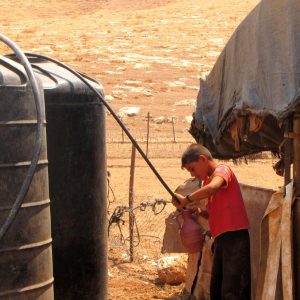Federal Water Tap, March 26: Budget Lifts Water Spending
The Rundown
Congress puts more money in water infrastructure loan programs. The GAO looks at climate risk disclosures submitted to financial regulators. The U.S. Supreme Court greenlights Flint class-action lawsuits. The BLM evaluates a carbon dioxide pipeline in Wyoming. And lastly the EPA plans to host a perfluorinated chemicals summit.
“Therefore, as a matter of national security, I’ve signed this omnibus budget bill. There are a lot of things that I’m unhappy about in this bill. There are a lot of things that we shouldn’t have had in this bill, but we were, in a sense, forced — if we want to build our military — we were forced to have. There are some things that we should have in the bill.
“But I say to Congress: I will never sign another bill like this again. I’m not going to do it again. Nobody read it. It’s only hours old. Some people don’t even know what is in — $1.3 trillion — it’s the second largest ever.” — President Trump’s comments on the budget he reluctantly signed.
By the Numbers
$300 million: Funding for the Great Lakes Restoration Initiative in the fiscal year 2018 budget, the level at which the program has been funded in recent years. (Congress)
$20 million: Funding in the budget for grants to test for lead in schools and child care centers. (Congress)
News Briefs
Bills Bill
The $1.3 trillion budget that Congress passed and President Trump signed bore little resemblance to the president’s proposal. The big cuts, even to the U.S. Environmental Protection Agency, did not come to pass. Water programs even got a boost. Almost across the board, areas that the Trump budget aimed to slash or eliminate — Land and Water Conservation Fund, National Estuary Program, water quality monitoring, plugging leaking underground storage tanks, and more — were restored or expanded.
The budget provides nearly $2.3 billion combined for the government’s flagship water-loan programs, the clean water and drinking water revolving funds. This is an increase of $600 million.
Funding for WIFIA, a newer loan program targeted at large projects, more than doubled, to $63 million.
The Rural Utility Services’ water and waste grant program received $560 million ($11 million less than in 2017) and $1.2 billion in loan authority.
Congress included $10 million for a two-stage health evaluation of exposure to perfluorinated chemicals on military bases. Used in fire-suppressing foams, the chemicals were deployed weekly for decades in fire training exercises. Spread on the ground, the chemicals found their way into groundwater and other water sources.
Congress also expressed interest in a number of policy issues. One is a burning legal question regarding the Clean Water Act: does it regulate pollution of groundwater that then flows to rivers and lakes? Several federal appeals courts are hearing lawsuits aimed at this distinction, and the EPA is taking public comment on its position that such discharges are covered under the law. In the budget, Congress asked the EPA to brief the relevant committees about its findings and about any plans for a rulemaking.
Another question, what are the risks to the Great Lakes of a proposed nuclear waste storage facility in Ontario? Congress ordered the State Department to submit a report on its diplomatic and legal strategy for engaging the Canadians.
In context: U.S. Courts Issue Contradictory Rulings on Groundwater and the Clean Water Act
Flint Lawsuits
The U.S. Supreme Court said that two class-action lawsuits filed in the wake of the Flint lead contamination scandal can proceed, Reuters reports. The lawsuits are directed at the alleged misdeeds of local and state officials.
Studies and Reports
Climate Risk Financial Reporting
Industry is satisfied with current financial disclosure requirements for climate risk while more and more investors are seeking additional and more-detailed data from companies. That is according to a U.S. Government Accountability Office review of U.S. Securities and Exchange Commission climate-risk disclosure policies.
Climate risks include higher temperatures, rising seas, carbon pricing policies that strand assets, water shortages, and others. The SEC published guidance in 2010 for companies on how to signal their exposure to such risks.
The quality of information included in these disclosures is all over the board. The GAO found some companies use boilerplate language with no data.
CO2 Pipeline Beneath Green River
A pipeline for transporting carbon dioxide for use in oil production in Wyoming would cross beneath the Green River if the company’s plans are approved. The details are laid out in the Bureau of Land Management’s draft environmental review of the Riley Ridge to Natrona Project.
The BLM must decide whether to allow the pipelines to cross federally managed public lands. The pipeline will cross 15 perennial waterways and 145 that flow intermittently.
On the Radar
PFAS Summit
The EPA sent letters to the governors of U.S. states and territories inviting them to a national meeting on perfluorinated chemicals. The closer regulators and utilities look, the more such compounds they find in water sources. The meeting will be held in Washington, D.C., on May 22 and 23.
Federal Water Tap is a weekly digest spotting trends in U.S. government water policy. To get more water news, follow Circle of Blue on Twitter and sign up for our newsletter.
Brett writes about agriculture, energy, infrastructure, and the politics and economics of water in the United States. He also writes the Federal Water Tap, Circle of Blue’s weekly digest of U.S. government water news. He is the winner of two Society of Environmental Journalists reporting awards, one of the top honors in American environmental journalism: first place for explanatory reporting for a series on septic system pollution in the United States(2016) and third place for beat reporting in a small market (2014). He received the Sierra Club’s Distinguished Service Award in 2018. Brett lives in Seattle, where he hikes the mountains and bakes pies. Contact Brett Walton





Leave a Reply
Want to join the discussion?Feel free to contribute!